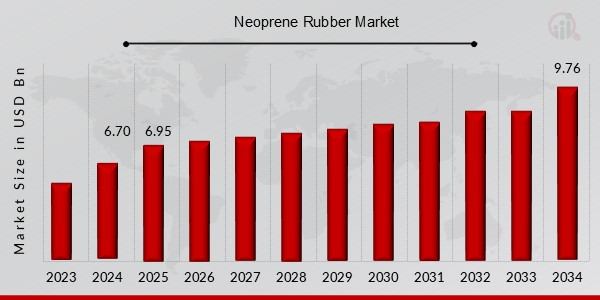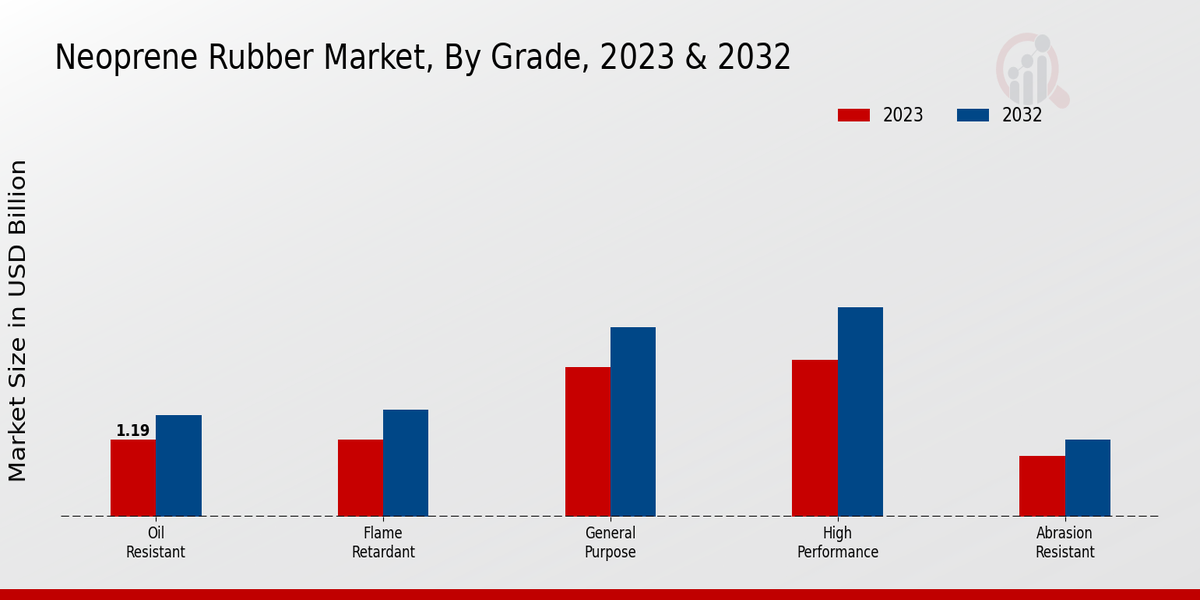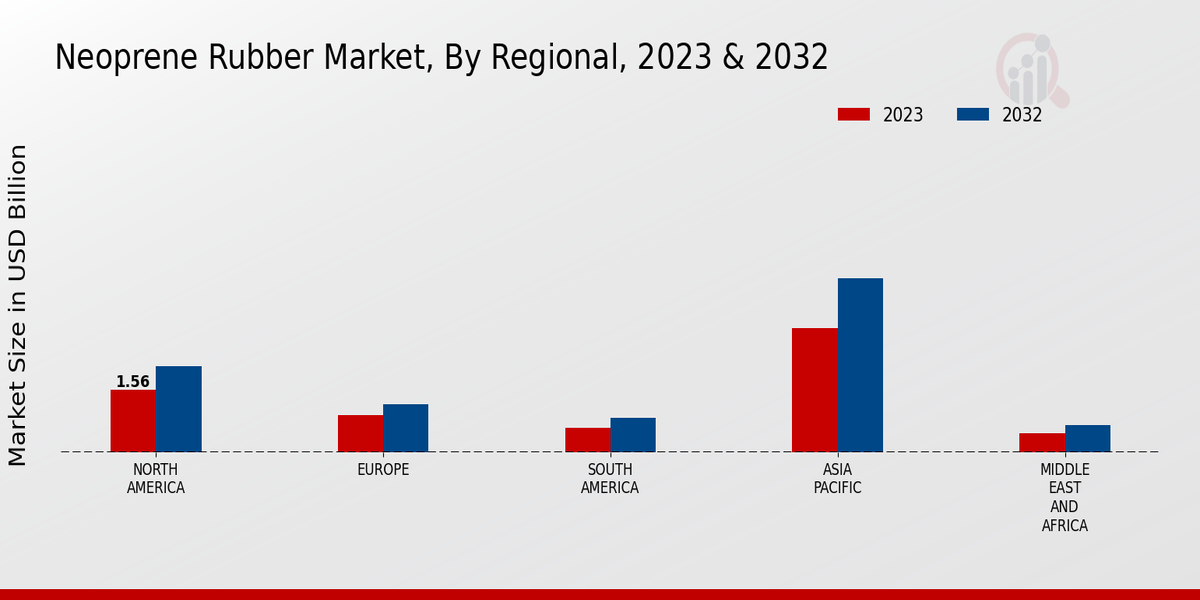Global Neoprene Rubber Market Overview
Neoprene Rubber Market Size was estimated at 6.70(USD Billion) in 2024. The Neoprene Rubber Industry is expected to grow from 6.95 (USD Billion) in 2025 to 9.76 (USD Billion) by 2034. The Neoprene Rubber Market CAGR (growth rate) is expected to be around 3.8% during the forecast period (2025 - 2034).
Key Neoprene Rubber Market Trends Highlighted
The neoprene rubber market is experiencing significant growth, driven primarily by its versatility and exceptional properties. Neoprene's resistance to heat, oil, and abrasion makes it ideal for applications in automotive, construction, and industrial settings. The increasing demand for energy-efficient and durable materials has further fueled market expansion.
Opportunities for growth lie in the exploration of innovative applications, such as in medical devices and electronics. Advancements in manufacturing processes have led to improved cost-effectiveness, opening up new markets. Sustainability concerns are also driving demand for eco-friendly neoprene alternatives.
Recent market trends include the rise of bio-based neoprene and the adoption of advanced production technologies, such as nanocomposites and graphene-based materials. These innovations enhance the performance and expand the application scope of neoprene.
The growing awareness of safety regulations and the need for high-quality materials in critical industries have also contributed to the market's growth trajectory.

Source Primary Research, Secondary Research, MRFR Database and Analyst Review
Neoprene Rubber Market Drivers
Rising Demand for Neoprene Rubber in Automotive Applications
Neoprene rubber is primarily used in the automotive industry, as the material is essential to produce such automotive parts as hoses, belts, seals, and gaskets.
The rise of automobile production, especially in the case of emerging markets, affects the demand for neoprene rubber, and the growing segment of electric automobiles contributes to the same effect. Neoprene rubber is used for producing neoprene coated high-voltage cables as well as some other electrical parts.
In this situation, the neoprene rubber market industry is expected to reach significant growth concerning the growing demand for the material from the automotive industry.
Growing Adoption of Neoprene Rubber in Construction and Infrastructure
Neoprene rubber is also gaining popularity in the construction and infrastructure sectors, where it is used in roofing membranes, expansion joints, and seismic isolation bearings. The increasing investment in infrastructure projects, particularly in developing countries, is expected to drive the demand for neoprene rubber.
Additionally, the growing awareness of the benefits of neoprene rubber, such as its durability, flexibility, and resistance to chemicals and weathering, is contributing to its adoption in these industries.
The Neoprene Rubber Market Industry is poised to experience substantial growth, driven by the rising demand from the construction and infrastructure sectors.
Expanding Applications of Neoprene Rubber in Healthcare and Consumer Products
Neoprene rubber is finding increasing use in the healthcare and consumer products industries. In healthcare, it is used in medical devices, such as catheters, tubing, and surgical gloves.
In consumer products, it is used in a variety of applications, such as wetsuits, diving equipment, and sports apparel. The growing demand for medical devices and consumer products, coupled with the unique properties of neoprene rubber, is expected to drive the growth of the Neoprene Rubber Market Industry in the coming years.
Neoprene Rubber Market Segment Insights
Neoprene Rubber Market Grade Insights
The Neoprene Rubber Market is segmented based on Grade into General Purpose, High Performance, Flame Retardant, Oil Resistant, Abrasion Resistant, and Chemical Resistant. The General-Purpose grade is expected to hold the largest market share in 2023, with a market value of USD 2.31 billion.
This is due to its wide range of applications, including in automotive parts, construction materials, and consumer products. The High-Performance grade is expected to grow at the highest CAGR of 4.2% from 2024 to 2032, owing to its superior properties, such as high strength, durability, and resistance to chemicals and temperature extremes.
The Flame-Retardant grade is expected to have a market value of USD 1.2 billion in 2023, driven by increasing demand from the construction and transportation industries. The Oil-Resistant grade is expected to grow at a steady CAGR of 3.5% from 2024 to 2032 due to rising demand from the automotive and industrial sectors.
The Abrasion Resistant grade is expected to have a market value of USD 950 million in 2023, supported by growing demand from the mining and construction industries. The Chemical Resistant grade is expected to grow at a CAGR of 3.8% from 2024 to 2032, driven by increasing demand from the chemical processing and pharmaceutical industries.

Source Primary Research, Secondary Research, MRFR Database and Analyst Review
Neoprene Rubber Market Process Insights
The Neoprene Rubber Market is segmented based on Process into Emulsion Polymerization, Solution Polymerization, and Suspension Polymerization. Emulsion Polymerization held the largest market share in 2023, accounting for over 55% of the Neoprene Rubber Market revenue.
This process involves the formation of small polymer particles in an aqueous medium, which results in high-quality neoprene rubber with improved properties. Solution Polymerization is expected to witness significant growth during the forecast period due to its ability to produce polymers with narrow molecular weight distribution and high purity.
Suspension Polymerization, on the other hand, held a smaller market share in 2023 and is expected to grow at a moderate pace due to its lower efficiency compared to other processes. Overall, the market growth is driven by the increasing demand for neoprene rubber in various industries, including automotive, construction, and healthcare.
Neoprene Rubber Market Form Insights
The solid form segment held the largest share of the neoprene rubber market in 2023, accounting for over 60% of the total revenue. This dominance is attributed to the extensive use of solid neoprene rubber in various industrial applications, including automotive components, construction materials, and electrical insulation.
The solid form offers high strength, durability, and resistance to heat and chemicals, making it suitable for demanding applications. The liquid form segment is projected to witness significant growth during the forecast period, owing to its increasing adoption of adhesives, sealants, and coatings.
The liquid form provides superior flexibility and adhesion properties, which are essential for applications where a strong bond is required. Moreover, the growing demand for liquid neoprene rubber in the electronics industry, particularly in the manufacturing of flexible printed circuit boards (PCBs), is expected to drive segment growth.
The latex form segment is anticipated to hold a moderate share of the neoprene rubber market. Neoprene latex is primarily used in the production of dipped goods, such as gloves, balloons, and condoms. The demand for neoprene latex in medical applications, such as surgical gloves, is expected to support segment growth.
Neoprene Rubber Market Application Insights
The application segment plays a crucial role in shaping the dynamics of the Neoprene Rubber Market. Among the key applications, automotive emerged as the dominant segment in 2023, accounting for roughly 32.4% of the market revenue.
The automotive industry's reliance on neoprene rubber for various applications, including seals, hoses, and belts, is a primary driver of this segment's growth. Construction was another significant application segment, representing approximately 27.1% of the market in 2023.
Neoprene rubber's durability, resistance to harsh weather conditions, and sound insulation properties make it ideal for roofing, flooring, and insulation applications in the construction sector.
The electrical industry also held a notable share of the Neoprene Rubber Market, with a contribution of around 18.9% in 2023. Neoprene rubber's insulating properties and resistance to heat and chemicals make it suitable for electrical wires, cables, and connectors.
Furthermore, industrial applications account for approximately 14.2% of the market, utilizing neoprene rubber for hoses, gaskets, and seals in various industrial settings. Lastly, consumer products, including footwear, sporting goods, and appliances, contribute around 7.4% to the market revenue.
Neoprene Rubber Market End User Insights
The Neoprene Rubber Market Segmentation by End User includes OEMs, Tier 1 Suppliers, Distributors, and End Consumers. OEMs, Tier 1 Suppliers, and Distributors play a crucial role in the supply chain, ensuring the seamless flow of Neoprene Rubber from manufacturers to end consumers.
In 2024, the Neoprene Rubber Market revenue from OEMs is projected to reach USD 2.12 billion, while Tier 1 Suppliers and Distributors are expected to contribute USD 1.65 billion and USD 1.24 billion, respectively. End Consumers, comprising various industries such as automotive, construction, and consumer goods, drive the demand for Neoprene Rubber.
The demand from the automotive sector is particularly significant, with Neoprene Rubber widely used in automotive parts and components due to its durability, resistance to wear and tear, and ability to withstand harsh environmental conditions.
Neoprene Rubber Market Regional Insights
The Neoprene Rubber Market is segmented into North America, Europe, APAC, South America, and MEA. Among these regions, APAC held the largest market share in 2023 and is expected to continue its dominance throughout the forecast period.
The growth of the APAC market can be attributed to the increasing demand for neoprene rubber in various industries such as automotive, construction, and healthcare. North America is the second-largest market for neoprene rubber, followed by Europe. The market in South America and MEA is expected to witness steady growth over the next ten years.

Source Primary Research, Secondary Research, MRFR Database and Analyst Review
Neoprene Rubber Market Key Players and Competitive Insights
Major players in the Neoprene Rubber Market are constantly vying for a competitive advantage, driving innovation and expanding their product offerings. These leading players engage in strategic initiatives, including mergers and acquisitions, partnerships, and collaborations, to strengthen their market positions and cater to evolving customer demands.
The industry landscape is characterized by intense competition, with key players adopting various strategies to differentiate themselves and gain market share. Their efforts are focused on developing advanced neoprene rubber formulations, expanding production capacities, and enhancing their presence through strategic investments and partnerships.
Collaboration and consolidation have become prominent trends in the Neoprene Rubber Market industry as companies seek to leverage synergies and expand their capabilities.
DuPont, a leading player in the Neoprene Rubber Market industry, is renowned for its extensive product portfolio and commitment to innovation. The company's focus on sustainability and environmental stewardship has enabled it to establish a strong brand reputation and maintain a competitive edge.
DuPont's investment in research and development has resulted in the introduction of advanced neoprene rubber formulations that meet the evolving demands of various industries. The company's presence, coupled with its robust distribution network, allows it to cater to customers worldwide. DuPont's commitment to customer satisfaction and technical support further strengthens its position in the market.
In contrast, Lanxess, another prominent player in the Neoprene Rubber Market, has gained recognition for its specialty elastomers and technical expertise.
The company's focus on high-performance materials has enabled it to develop innovative neoprene rubber solutions tailored to specific industry applications. Lanxess' commitment to sustainability and eco-friendly practices has resonated with customers, contributing to its strong brand image.
The company's strategic partnerships with key industry players have expanded its market reach and enabled it to offer comprehensive solutions to its customers. Lanxess' emphasis on customer collaboration and technical support has further solidified its position as a leading competitor in the Neoprene Rubber Market.
Key Companies in the Neoprene Rubber Market Include
-
Zeon Corporation
-
Sumitomo Chemical
-
Asahi Kasei Corporation
-
LANXESS
-
JSR Corporation
-
Showa Denko
-
LG Chem
-
SABIC
-
SK Chemicals
-
Mitsui Chemicals
-
DuPont
-
Bayer MaterialScience
-
Denka
-
ExxonMobil Chemical
-
Tosoh Corporation
Neoprene Rubber Market Industry Developments
The increasing demand for neoprene rubber in various end-use industries, such as automotive, construction, and healthcare, is driving market growth. The growing adoption of neoprene rubber in automotive applications, including hoses, seals, and gaskets, is a major factor contributing to market expansion.
Moreover, the rising demand for neoprene rubber in the construction industry for roofing and flooring applications is further fueling market growth.
Additionally, the increasing use of neoprene rubber in healthcare applications, such as medical devices and protective gear, is expected to drive market demand in the coming years.
Neoprene Rubber Market Segmentation Insights
Neoprene Rubber Market Grade Outlook
General Purpose
High Performance
Flame Retardant
Oil Resistant
Abrasion Resistant
Chemical Resistant
Neoprene Rubber Market Process Outlook
Emulsion Polymerization
Solution Polymerization
Suspension Polymerization
Neoprene Rubber Market Form Outlook
Solid
Liquid
Latex
Neoprene Rubber Market Application Outlook
Automotive
Construction
Electrical
Industrial
Consumer Products
Neoprene Rubber Market End User Outlook
OEMs
Tier 1 Suppliers
Distributors
End Consumers
Neoprene Rubber Market Regional Outlook
North America
Europe
South America
Asia Pacific
Middle East and Africa
|
Report Attribute/Metric
|
Details
|
|
Market Size 2024
|
6.70(USD Billion)
|
|
Market Size 2025
|
6.95(USD Billion)
|
|
Market Size 2034
|
9.76(USD Billion)
|
|
Compound Annual Growth Rate (CAGR)
|
3.8% (2025 - 2034)
|
|
Report Coverage
|
Revenue Forecast, Competitive Landscape, Growth Factors, and Trends
|
|
Base Year
|
2024
|
|
Market Forecast Period
|
2025 - 2034
|
|
Historical Data
|
2020 - 2024
|
|
Market Forecast Units
|
USD Billion
|
|
Key Companies Profiled
|
Zeon Corporation, Sumitomo Chemical, Asahi Kasei Corporation, LANXESS, JSR Corporation, Showa Denko, LG Chem, SABIC, SK Chemicals, Mitsui Chemicals, DuPont, Bayer MaterialScience, Denka, ExxonMobil Chemical, Tosoh Corporation
|
|
Segments Covered
|
Grade, Process, Form, Application, End User, Regional
|
|
Key Market Opportunities
|
The growing automotive industry
Increasing demand for the construction sector
Rising adoption in consumer products
Expanding medical and healthcare applications
Escalating use in aerospace and defense
|
|
Key Market Dynamics
|
Increasing construction activities
Growing automotive industry
Rising demand from Asia-Pacific
Environmental concerns
Technological advancements
|
|
Countries Covered
|
North America, Europe, APAC, South America, MEA
|
Frequently Asked Questions (FAQ) :
The Neoprene Rubber Market reached a valuation of approximately 6.70 billion USD in 2024.
The Neoprene Rubber Market is expected to exhibit a CAGR of around 3.8% from 2025 to 2034.
The Asia-Pacific region is anticipated to lead the Neoprene Rubber Market in 2032.
Neoprene Rubber finds extensive applications in automotive parts, construction materials, electrical insulation, and consumer products.
Prominent players in the Neoprene Rubber Market include DuPont, Dow, Lanxess, and Arkema.
The Neoprene Rubber Market is projected to reach a valuation of approximately 8.71 billion USD by 2032.
The automotive parts segment is anticipated to exhibit the highest growth rate in the Neoprene Rubber Market.
Increasing demand for lightweight and durable materials, rising automotive production, and growing construction activities are key factors driving market growth.
Fluctuating raw material prices, environmental concerns, and competition from alternative materials pose challenges to the market.
The Asia-Pacific region is anticipated to present lucrative growth opportunities in the Neoprene Rubber Market.
















